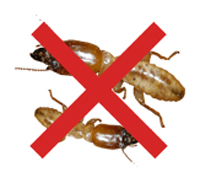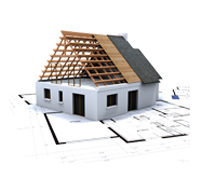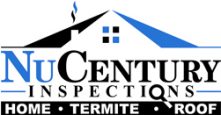Vikane is a colorless, odorless gas that quickly penetrates structural materials during whole-structure fumigation. Vikane, backed by nearly 50 years of university research, practical use and published reports is nonstaining, noncorrosive and nonflammable. Vikane quickly dissipates from the structure into the atmosphere and does not damage the ozone layer.
Many title companies require that a home is treated for termites before it can be purchased. Also, most buyers expect the home that they are purchasing is going to be treated.
Whole-structure fumigation with Vikane gas fumigant meets all state and lender requirements for real estate transactions. Whole-structure fumigation is the best drywood termite treatment because it gives both the buyer and seller peace of mind that all of the drywood termite colonies have been eliminated.
Fumigation professionals calculate the fumigant dosage they use based on the target pest they are eliminating, such as drywood termites. If you would like to control other pests in your home, talk to your local fumigation professional about setting up a specific pest control plan for those pests. We only guarantee for the target pest we are fumigating for.
If you see a few live termites immediately after your home has been fumigated, don’t be alarmed. Sometimes it can take three to five days for all of the termites to die. Rest assured whole-structure fumigation with Vikane gas fumigant will eliminate all of the drywood termites in the home.
Removing your fish aquarium from your home is the best possible option. If that cannot be done, it is important to work with your fumigation professional to determine the best way to protect aquarium organisms during the fumigation.
Vikane gas fumigant does not react with most materials and is unlikely to cause damage. Your licensed, trained fumigation professional will inspect your property to help ensure that your contents will not be affected.
No. Sulfuryl fluoride, the active ingredient in Vikane gas fumigant, is not an ozone-depleting chemical. Vikane contains no chlorine or bromine and, thus, does not deplete stratospheric ozone by the known mechanisms. When a structure is aerated, Vikane rapidly dissipates to non-detectable levels. In 2002 Dow AgroSciences was awarded the Stratospheric Ozone Protection Award by the United States Environmental Protection Agency. This award recognizes extraordinary achievements, international leadership and innovation in preserving the ozone layer.
The fumigation process is a three day process for Drywood Termites and a four day process for Beetles.
It takes approximately two hours to put the tarps on depending on the size of the structure.
It takes approximately two hours to take the tarps down depending on the size of the structure.
We prefer antennas to be removed; however we can tape around the antenna if necessary.
Doors and windows are left open only when we are there to supervise the property. We never leave the doors and windows open unsupervised.
The gas dissipates on its own with the natural air circulation throughout the property.
Remove, trim, or rake back any plants, flower pots, bushes, rocks, branches, etc. that are up against the property at least twelve inches. Antennas need to be taken down and fence boards removed.
Any foods, medications, anything living: people, pets, and plants.
We recommend that all food be removed entirely from the property. If your primary contractor (termite company) provides you with Nylo Fume bags, you may double bag your food and put it back in your refrigerator, freezer, or store on kitchen if refrigeration is not necessary. If they do not provide bags, all food items must be REMOVED from the property. THIS IS REQUIRED BY LAW.
Make-up, shampoo/conditioner, and lotions DO NOT need to be removed. The gas does not have an odor and does not leave any residue. The gas will not have any chemical reactions with these items.
The sprinkler system does not have to be turned off as long as the timer does not go off while we are tenting the property. Automatic light timers must be turned off if the lights are outside so that the tarps are not melted. Alarm systems may be left on but we do need the alarm code if you choose to do so.
Items do not have to be completely removed but access area to the crawl space or attic must be cleared.
If the safe is big enough to fit a human being inside, we are required to look inside the safe. The Safe may be locked after we do so.
The fumigators must go inside the property to insure no living beings remain inside, and that proper preparation has been done.
The soil must be watered in order to soak up the roots of the plants on the outside of the property and to help get a better seal when we tent the property.
Infant/baby, hospital, and any mattress with vinyl type of fabric covering must be removed from the property. If you have a sipped plastic/vinyl mattress cover, you only have to unzip the end of the cover. The same holds true for zippered clothing bags. They need to be unzipped.
The ice in the ice maker should be emptied out after the fumigation is completed.
The water softening system does not have to be removed or cleaned out during or after the fumigation.
Plants will not necessarily die under the tent but we cannot guarantee their survival. We recommend you water them well the night before or completely remove the plants from the property.
When performing fumigations it is necessary to walk and or work on roofs of structures. This obviously creates situations where damage to delicate or old roofs can be unavoidable. We do not wish to unnecessarily damage anyone’s floor and user our best care to insure minimal damage if any.
We will call to schedule the gas shut off. It is the responsibility of the homeowner/tenant to call PG&E to schedule the gas to be turned on.
The key will be secured during the fumigation process. Secondary locks will be used to prevent anyone other than our fumigators to enter the property.
The mail will be redelivered after the tents come off the property if the mailbox is connected to the structure.
The occupant may reenter their property anytime after 1pm on the final day of the fumigation.
NuCentury Inspections guarantees we have eliminated Beetles and / or drywood termites within the space fumigated for a period of (3) year from the date of completion.
Cars can be left inside the garage if we have access to the trunk and the doors are unlocked.
Yes, that is why all drawers, cupboards, trunks, vaults, doors & windows must be opened.
We use fans and open all drawers, cupboards, trunks, vaults, doors & windows.
The gas we use leaves no residue, so washing items is not necessary.
An infestation implies an established colony, and evidence of established colony usually takes three to five years to show, after they have established themselves in a property.
Depending on the type of tile and age, some tiles may be broken. We do however take every possible precaution to reduce the amount of tiles that will be broken.
Currently only as a matter of courtesy, however if we require access to any part of their property to be able to complete our work, then a neighbors release will be needed.


